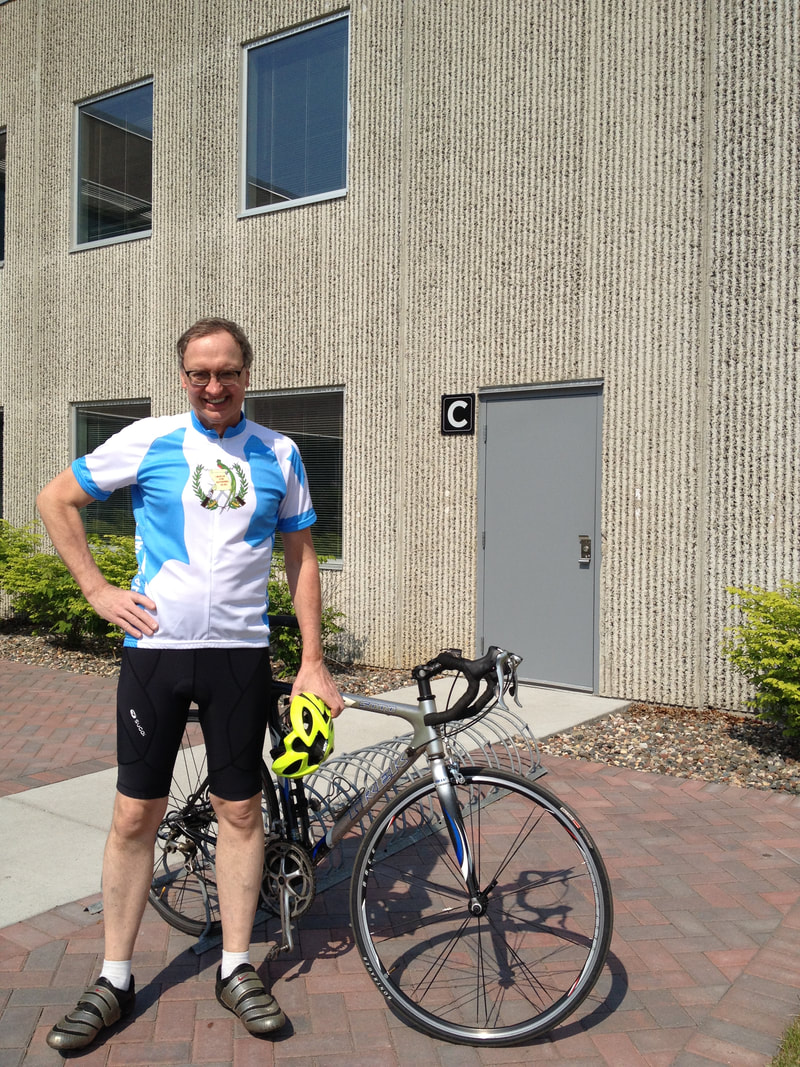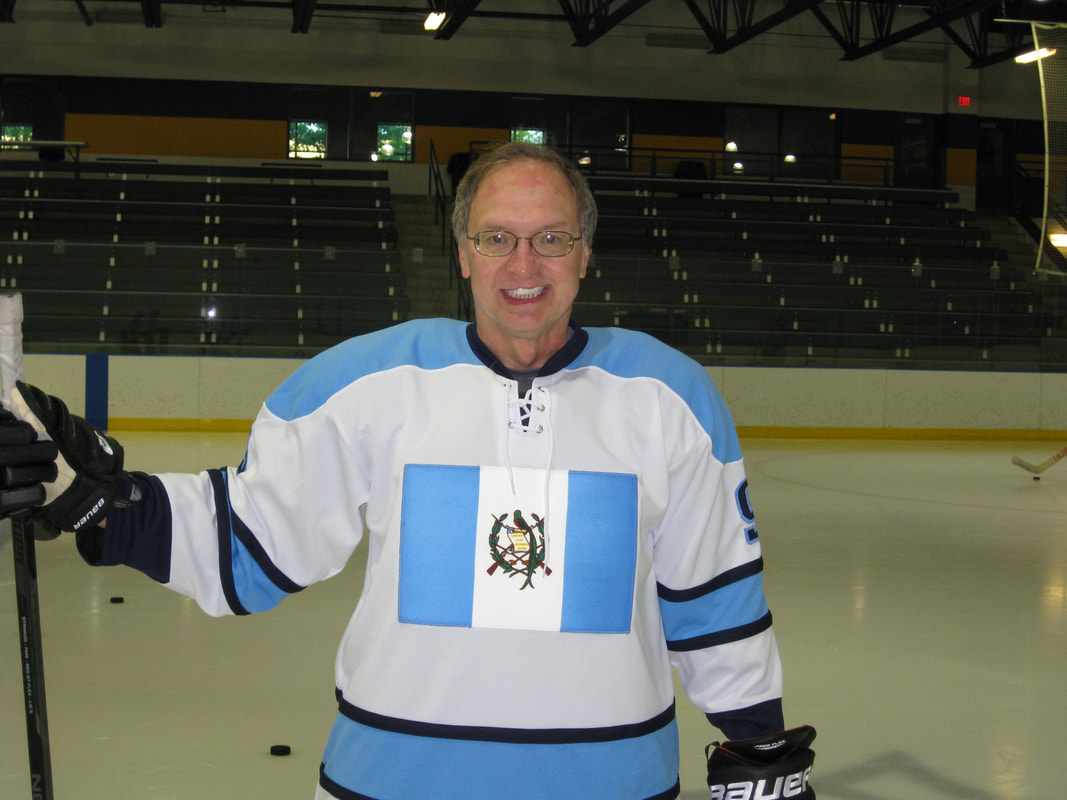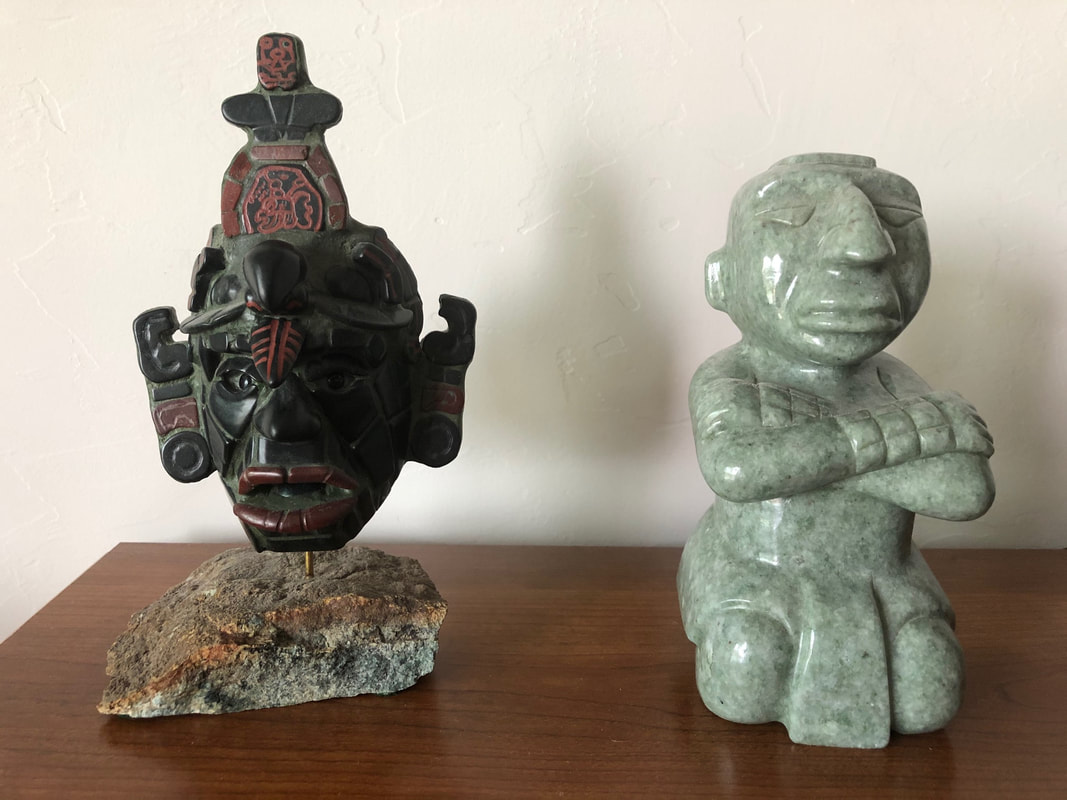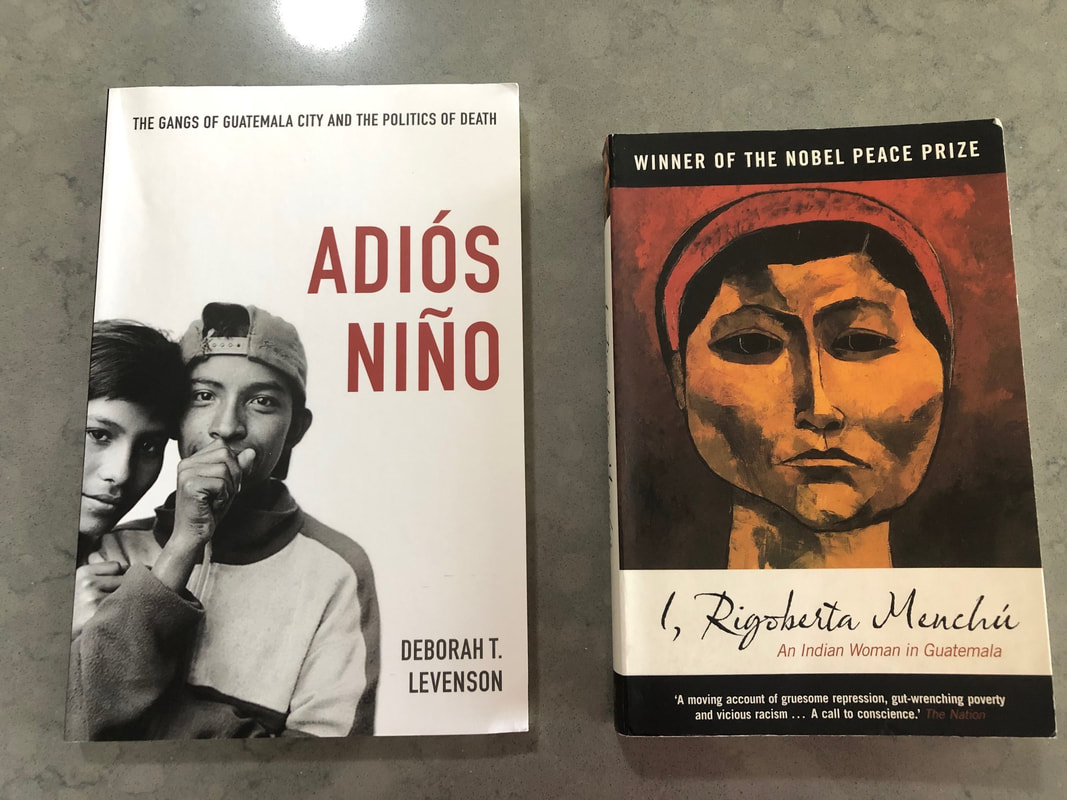Guatemala? Sí!
From 30 March to 8 April 2014 I traveled to Guatemala City to spend time with the good people at Alimentos SA, where I trained thirty of the plant's personnel, across all disciplines, in what I know about the art and science of the twin-screw extruder. It was one of the two or three best experiences of my career.
Logistics
I flew Delta from Minneapolis to Atlanta to Guatemala City, getting upgraded to first class on the second leg of the journey. The total air time of five and a half hours required me to pass through three time zones: Central to Eastern to Mountain. The first of ten days of surprises started when I walked into the terminal and saw it was modern and large, neither of which I expected. Because Delta misplaced the smaller and least important of the two bags I checked, I passed through Customs last, even though I was first getting through Passport Control. But both, happily, were easy. (Delta delivered the suitcase to my hotel the next morning, so there was no practical inconvenience to this.) Joel Lopez, the young and personable driver Alimentos arranged and paid for, met me in the arrival area, as planned, and drove me the fifteen minutes to the hotel in Zone 10 (of twenty-two) in Guatemala City, the country's capital, whose Sunday night roads were free of traffic.
On the return trip, Delta upgraded me to first class for both segments, and, like the outgoing trip, the front of the plane was not full. I needed a good portion of the two-and-a-half-hour layover in Atlanta to slog through the long, slow line at Passport Control. (All four flights arrived a few minutes ahead of schedule.)
On the return trip, Delta upgraded me to first class for both segments, and, like the outgoing trip, the front of the plane was not full. I needed a good portion of the two-and-a-half-hour layover in Atlanta to slog through the long, slow line at Passport Control. (All four flights arrived a few minutes ahead of schedule.)
In Country Accommodations and Travel
Alimentos SA paid for my stay at the Hotel Stofella, a Best Western property that was somewhat old but well-maintained and light-years ahead of the Best Western properties I've stayed at the the U.S. My room was quiet and comfortable, with a wide-screen television that received ninety-eight channels, most in Spanish but some in English, French, German, and Mandarin. The water from the tap was not safe to drink, but the hotel provided two bottles of drinking water a day and as many as I'd want just a phone call away. Their fitness center was being renovated and thus not available during my stay; the breakfast buffet did not open until seven o'clock, so for all but two of my morning meals I ate at a nearby McDonald's, which opened at six.
Joel was also my driver for the daily round-trip to and from the factory. After the first day he picked me up at 07:20, which put me at the plant, after passing through security, where I usually had to surrender my driver's license (returned each afternoon), at 07:45. Joel and I normally agreed upon a time for him to meet me at the plant; if that changed, then one of the secretaries would call him with the updated schedule. If we left the plant by 16:30, then the drive back to the hotel was about forty-five minutes; if we left at 17:00, then, with the city's notorious traffic, the ride was seventy minutes. I signed a voucher every day, including Saturday, when Joel drove me to Antigua, to acknowledge I did use his taxi service.
Zone 10, also known as Zona Vida, is considered the nicest section of Guatemala City. Along with at least one security officer carrying a 12-gauge shotgun or an AK-47, each block had two or more restaurants, either familiar franchises or local shops. Across the street from the Hotel Stofella, for instance, was an Applebee's, and, as I mentioned above, a McDonald's, forty years in Guatemala, was about thirty meters from the hotel. Walk, say, a mere half-kilometer from the hotel in any direction and you'll find Burger King, TGIFridays, Pizza Hut, Chili's, Dunkin' Donuts, and three times as many local restaurants, serving, literally, every variety of food. Also within a few blocks of the Stofella were other hotels, including a Holiday Inn, an Intercontinental, and a Radisson. Last, a safe twenty-minute stroll was the Oakland Mall, four contemporary levels of shopping and eating and entertainment that would fit in seamlessly in any upscale neighborhood in the States. Oakland mall had a bookstore with a tiny section of English-language books; in Fontabella Plaza, three blocks from the hotel, was Sophos, a fine bookstore with a substantial number of quality books in English.
Joel was also my driver for the daily round-trip to and from the factory. After the first day he picked me up at 07:20, which put me at the plant, after passing through security, where I usually had to surrender my driver's license (returned each afternoon), at 07:45. Joel and I normally agreed upon a time for him to meet me at the plant; if that changed, then one of the secretaries would call him with the updated schedule. If we left the plant by 16:30, then the drive back to the hotel was about forty-five minutes; if we left at 17:00, then, with the city's notorious traffic, the ride was seventy minutes. I signed a voucher every day, including Saturday, when Joel drove me to Antigua, to acknowledge I did use his taxi service.
Zone 10, also known as Zona Vida, is considered the nicest section of Guatemala City. Along with at least one security officer carrying a 12-gauge shotgun or an AK-47, each block had two or more restaurants, either familiar franchises or local shops. Across the street from the Hotel Stofella, for instance, was an Applebee's, and, as I mentioned above, a McDonald's, forty years in Guatemala, was about thirty meters from the hotel. Walk, say, a mere half-kilometer from the hotel in any direction and you'll find Burger King, TGIFridays, Pizza Hut, Chili's, Dunkin' Donuts, and three times as many local restaurants, serving, literally, every variety of food. Also within a few blocks of the Stofella were other hotels, including a Holiday Inn, an Intercontinental, and a Radisson. Last, a safe twenty-minute stroll was the Oakland Mall, four contemporary levels of shopping and eating and entertainment that would fit in seamlessly in any upscale neighborhood in the States. Oakland mall had a bookstore with a tiny section of English-language books; in Fontabella Plaza, three blocks from the hotel, was Sophos, a fine bookstore with a substantial number of quality books in English.
Language
Most of the fifteen million people in Guatemala, including the 1.1 million in the capital city, do not speak English. But having studied Spanish in high school, having had the opportunity to use it on and off since, and having spent the past six weeks drilling into my head the first two levels of Fluenz Latin American Spanish, helped me enormously in navigating my way through the trip. I don't pretend to be fluent, because I'm not, but I was able to communicate in simplified version of the natives' language when necessary, which made my experience less complicated and often more amusing. I recommend to anyone traveling to Guatemala to practice, practice, practice your Español as much and as far in advance as possible. I plan on finishing the five-volume Fluenz course by sometime in August to improve my facility with the language.
Extrusion Workshop
I will mention only a few non-technical details in this section.
Okay, now for the reason I visited Alimentos—the workshop. But first I have to say the Alimentos plant, which employs six hundred, makes cereal and snacks, and includes a fully functioning mill, is as clean and as well-run as virtually any food plant I've been in over the past thirty-three years. It might be a reflection of my own ignorance, but I was not expecting it to be of this caliber. All concerned should be proud of what they've done and continue to do at this location.
The students, with varying levels of English ability—some spoke as well as many Americans; a few didn't speak English at all—were an absolute pleasure to work with, their enthusiasm and eagerness to learn were irresistible. Our communication gap was bridged during the lectures by two translators sitting in an enclosed booth in the classroom, listening with a headset to me speaking in English, and delivering instantly through a microphone to the class, also wearing headsets, my words in Spanish. This, itself, was fascinating, from an anthropological perspective as well as a pedagogical one.
The students, with varying levels of English ability—some spoke as well as many Americans; a few didn't speak English at all—were an absolute pleasure to work with, their enthusiasm and eagerness to learn were irresistible. Our communication gap was bridged during the lectures by two translators sitting in an enclosed booth in the classroom, listening with a headset to me speaking in English, and delivering instantly through a microphone to the class, also wearing headsets, my words in Spanish. This, itself, was fascinating, from an anthropological perspective as well as a pedagogical one.
Photographless Memories
For reasons completely unknown to me I snapped no photos during this ten-day trip. And I'm living to regret it. The pictures below are related to my Guatemalan adventure, but they're from back at home in the Twin Cities, not long after I returned. To keep Guatemala close to my heart I tracked down and bought a bicycle jersey based on the Guatemalan flag; then I bought a small facsimile of the flag and had the Canadian company, IceJerseys.com, assemble for me what is certainly the only Guatemalan ice hockey jersey in the world.
The timing of this trip was such that I had a weekend off—and I took full advantage of it, exploring more of Guatemala City and taking what was going to be a day-trip to popular Antigua, a UNESCO World Heritage Site and once capital of the Kingdom of Guatemala. It's a destination for those wishing to learn Spanish in immersive courses and for U.S. travelers looking for what they perceive as a safer vacation in country than they might otherwise enjoy in the capital city.
I must confess I'm in the minority regarding Antigua, in that I didn't like it at all. It was artificial, with an overabundance of souvenir shops and self-consciously cute cafes and coffee houses and, judging from the accents I heard, plenty of Yankees. I ended up spending less than two hours there and was happy to return to the city. I did buy two keepsakes at the museum I walked through, shown in the photo below.
I must confess I'm in the minority regarding Antigua, in that I didn't like it at all. It was artificial, with an overabundance of souvenir shops and self-consciously cute cafes and coffee houses and, judging from the accents I heard, plenty of Yankees. I ended up spending less than two hours there and was happy to return to the city. I did buy two keepsakes at the museum I walked through, shown in the photo below.
The only other lasting purchases I made were two English-language books with a Guatemalan theme at the Sophos bookstore I mentioned earlier. Both had a political-sociological slant—common in books anywhere in Central America—and I ended up enjoying each of them.
Such was my work trip to Guatemala, which in all regards caught me completely by surprise. I was lucky enough to return about four months later to commission the extruder they bought from Bühler and to help out with their existing processes. A thousand thanks to Alimentos folks Adolpho, Andrea, Bernan, Dieter, Douglas, Emilio, Francisco, a second Francisco, Gladys, Gloria, Indra, José Miguel, Julio, Maria, Marta, Melany, Pablo, Paola, Rudolpho, Sandra, and others whose names I can't remember now for their hospitality and friendship. I don't know if we'll ever meet again but know your place in my heart is secure forever.




